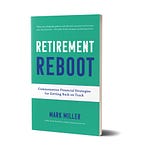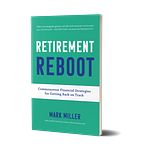
This week, the podcast revisits a topic I wrote about for The New York Times last month - race and retirement. I’ve written before about how the inequities people of color experience during their working lives spill over into retirement. But during this time of racial reckoning, I wanted to take a deeper dive into the topic.
For the Times story, I took special care to seek out the voices of Black Americans who also are expert on this topic. That’s how I found my way to economist Darrick Hamilton. Professor Hamilton is one of the nation’s leading voices on the causes and consequences of racial and ethnic economic disparities. He recently left Ohio State University to rejoin The New School in New York City, where he is teaching and starting up a new Institute for the Study of Race, Stratification and Political Economy.
Darrick is a leading proponent of one of the most creative ideas for addressing the racial wealth gap - “baby bonds.” The idea is to provide every American child with a government-funded trust account at birth, starting with a $1,000 contribution. Kids born into lower-wealth families would receive more contributions over time, and the accounts would benefit from compound interest growth.
The premise is that much of the wealth in the U.S. is transferred from generation to generation, and there’s a powerful compound effect that starts with our legacy of racist laws and policies and ends with today’s white households able to access far more capital for wealth-building activities - attending college, buying a home or starting a business. Baby bonds could serve as a proactive remedy for that injustice, and in many cases could impact the wealth available at retirement for people of color.
In the Times story, I outline the basic numbers on race and retirement. They may not be surprising, but they certainly are appalling.
In 2016, the typical Black household approaching retirement had 46 percent of the retirement wealth of the typical white household. For a Latino family, it was 49 percent. Two-thirds of single black retirees have incomes too low to meet basic living expenses.
And that was before the pandemic. Since COVID19 struck, unemployment rates for older Black and Latino workers have been much higher than for their white counterparts. And mounting evidence suggestions that millions are being forced into premature retirement. That’s going to translate into sharp cuts in Social Security income and savings, and expensive disruptions in health insurance.
The baby bonds concept has caught on in the Democratic party - Senator Cory Booker advocated for it during his presidential campaign and he has sponsored baby bond legislation in the Senate. The idea also has found its way into the Biden presidential campaign.
Listen to my conversation with Darrick Hamilton by clicking on the player icon at the top of the newsletter. The podcast also can be found on Apple Podcasts, Spotify and Stitcher.
Not a subscriber yet? Take advantage of a special offer

Sign up now for the free or subscriber edition of the newsletter, and I’ll email a copy of my latest retirement guide to you. This one looks at dealing with the Social Security Administration during the COVID19 crisis.
Customer service at the Social Security Administration has changed during the coronavirus crisis - the agency closed its network of more than 1,200 field offices to the public in March.
Just a reminder- subscribers, have access to the entire series of guides at any time. Click on the little green button to subscribe, or go here to learn more.
Will FICA revenue deferral open the door to privatization of Social Security? Here’s how it could play out

I've been writing over the summer about the threat posed to Social Security by President Trump’s threat to continue deferring FICA tax collections should he win reelection. This has been a chaotic episode, with shifting indications from the White House on how a FICA revenue gap might be plugged. And most employers seem to be ignoring the deferral altogether as not worth the bother, and are continuing to collect FICA. Even the U.S. Chamber of Commerce - a staunch Trump ally - has expressed disapproval.
Trump signed a presidential memorandum in August ordering the deferral through year-end of FICA revenue, and he also said that he would push for termination altogether of the tax if he wins a second term. It’s not at all clear that he could push this through Congress, but some experts think that the IRS code might permit him to defer FICA collections for an additional year.
If we do stop funding Social Security through FICA, just about anything can happen. The concept of an earned benefit can go out the window pretty quick, and people will start thinking of Social Security as welfare.
In the political back and forth over FICA, the Trump administration has stated that any deferred FICA revenue would be replaced by general revenue funds. But that suggests a transfer of more than $1 trillion annually - a tall order for a Congress already grappling with the demands of economic support for a flagging economy.
It also would mark a turning point in Social Security’s funding structure. The program has always been funded mainly by FICA (it also receives relatively small amounts of revenue from taxes on benefits and interest on trust fund bonds.). Self-funding has been one of the program’s political strengths, as it gives workers and beneficiaries a sense of ownership - as per this oft-quoted 1941 quip from President Franklin Roosevelt:
“We put those payroll contributions there so as to give the contributors a legal, moral, and political right to collect their pensions and their unemployment benefits. With those taxes in there, no damn politician can ever scrap my social security program. Those taxes aren’t a matter of economics, they’re straight politics.”
Some Republicans have not given up on the dream of converting Social Security into a system of personal saving accounts - an anchoring idea of the reforms proposed by President George W. Bush. The plan was a political and policy flop, but some on the right continue to push it, including the Heritage Foundation.
If you doubt this, check out this recent op-ed on FICA by Andrew Biggs of the American Enterprise Institute (emphasis added at the conclusion of this passage):
. . . President Trump made clear in an Aug. 12 news conference that his real goal is to replace the Social Security payroll tax with revenues drawn from the general tax fund, the vast majority of which is income taxes. This idea faces both practical and philosophical hurdles, but could help the political parties finally come together to fix Social Security.
The first problem with funding Social Security via income taxes is obvious: the federal budget is already in deficit, which means there isn’t room to fund Social Security with general revenues without significantly cutting other programs or raising income taxes. And that tax increase wouldn’t be tiny. In 2019, the federal government collected about $1.7 trillion in individual income taxes, versus nearly $1 trillion in Social Security payroll taxes. Even if the President’s plan would replace only the employees’ 6.2% payroll tax, that would mean about an additional $500 billion in general tax revenues needed.
Moreover, funding Social Security with income taxes is also contrary to the program’s history, in which benefit were funded with a flatrate tax that applied to all earnings up to a maximum, which is currently $137,700 per year. The payroll tax contributed to the view that Social Security is an “earned benefit” rather than a welfare plan.
But most Democrats have already given up on the idea of truly earned benefits, since their Social Security proposals focus on lifting the payroll tax cap and making the rich carry more of the load.
Income-tax financing would simply take that idea in a more progressive direction. While about 15% of earnings accrue to employees with salaries above the $137,700 payroll tax ceiling, almost half of total income taxes are paid by households with incomes above that level. More than one-third of income taxes are paid by the top 1% alone.
But what is in it for Republicans? The answer is that an income-tax-financed safety retirement net need not be nearly as expensive as the current Social Security program. For instance, Australia’s Age Pension costs around one-fifth of what Social Security does, because it merely supplements households’ own savings to ensure a minimum standard of living in retirement. Canada and New Zealand also use income tax-financed programs to provide a strong base of retirement income.
For this idea to work, though, the U.S. would need to follow Australia’s lead by signing up every worker for a retirement savings account with automatic contributions. Those contributions could be funded using the payroll taxes that no longer would be needed to fund Social Security.
Biggs was a deputy commissioner of Social Security during the Bush administration and he was involved in the aforementioned failed effort to convert Social Security into a system of private savings accounts. He hasn’t talked much about privatization in recent years - until now, that is:
Once transitioned into place — which admittedly would take years — the result would be higher private savings, particularly for lower-income households, which reduces wealth inequality and boosts the economy. And while income taxes would be higher, total government spending on Social Security would be lower.
To be clear, this is my plan, not President Trump’s. But for income tax-funding of Social Security to work, for it to overcome 30 years of Congressional inaction on Social Security, it needs to think creatively and offer something to both sides. Because the traditional menu of reforms — payroll tax rate increases, higher retirement ages, lower cost-of-living adjustments and so forth — haven’t motivated Congress to action.
Joe Biden has been hammering Trump on the FICA issue in television ads running in swing states. We are living in a very weird world, indeed, when the chief actuary of Social Security is quoted in a political ad.










